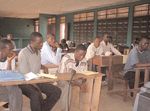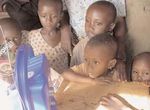Giving Voice to the Voiceless - Africa and Afghanistan - the United Nations
←
→
Page content transcription
If your browser does not render page correctly, please read the page content below
Giving Voice to the Voiceless
Africa and Afghanistan
While others scour the local market for staples like places where roads are bad and literacy is low, where
cornmeal and cooking oil, João Bernardo Golombole electricity is scarce and batteries are pricey. We’ve
looks for news and insight. Decades of armed handed out 2,000 wind-up radios in Angola alone.”
conflict have taken their toll on Angola, and towns
like Seles, in the coastal province of Cuanza Sul, Best of all, the communication flows two ways:
are still picking up the pieces. Golombole wants to not only keeping vulnerable populations informed
know how they’re doing. Plugging a microphone but also conveying their concerns to fellow citizens
into his palm-sized minidisc recorder, he crouches living hours away. The United Nations Trust Fund
in the dust beside a vendor named Maria. She tells for Human Security supports the radio initiative so
him of the drought that has ruined the harvest, that at-risk people and communities can access i u
and how she now makes charcoal to support her vital information and use it to address critical chal- IRIN’s programming not only Like these two radio reporters,
keeps vulnerable populations many of the Afghan journal-
family. The interview later airs on national radio, lenges. IRIN’s coverage of these places also serves
informed but also conveys ists working closely with IRIN
carrying Maria’s words far and wide. as an early warning system, alerting the outside
their concerns to fellow citizens broadcast their stories on
world to pressing needs and emerging threats. living hours away. “Radio is the independent stations that
22 Communities like Seles rarely make the news in cheapest, most readily avail- are owned and operated by
Angola, but a new radio broadcasting initiative is IRIN started in the wake of the 1994 genocide in able source of information in women. IRIN PHOTO
slowly changing all that. Now fully operational Rwanda, as a way for humanitarian organizations these areas,” says Dalton. “It
reaches places where roads are Children in Angola listen to a
in seven African nations plus Afghanistan, the working there to share information. Soon it began
bad and literacy is low, where wind-up radio. IRIN has distrib-
initiative is among the latest o≠erings from the publishing its own news and analysis and making electricity is scarce and batter- uted 2,000 of these devices,
Integrated Regional Information Network (IRIN), documentary films, mostly in English. The radio ies are pricey.” IRIN PHOTO which are powered by a clock-
a multimedia news service run by the United initiative began in 2001 in Somalia. It then added work mechanism and a solar
Nations O≤ce for the Coordination of Humanitarian coverage, in local languages, of Afghanistan, Angola, panel, in remote parts of
Angola. IRIN PHOTO
A≠airs. Like IRIN’s website, which carries topical Burundi, Côte d’Ivoire, Lesotho, Liberia and Sudan.
reports by veteran journalists and aid workers, the
radio initiative o≠ers timely, credible coverage of In Afghanistan, IRIN Radio holds workshops where
communities facing perils like hunger, disease, local journalists—half of them women—upgrade
hatred and war. their skills and explore ways to cover the issues
most relevant to their audiences. After decades of
In locations like these, television and the Internet repression and strife, the nation is still adjusting
are not yet up to the task. “Radio is the cheapest, to the idea of an independent press. “Many univer-
most readily available source of information in these sities here still teach the old Soviet methods,” says
areas,” says Mark Dalton, a veteran aid worker who Sayed Abdul Rahim Rahmani, 24, a rising star among
is IRIN’s representative in New York. “It reaches Afghan journalists. “From IRIN we’ve learned howBetter communication between
i
A female reporter interviews remote communities and urban
a family in Afghanistan. IRIN
centers is a critical factor in
conducts workshops where
Afghan journalists—half of achieving human security. Radio
them women—can upgrade
their skills and explore ways provides a way for vulnerable
to cover the issues most
groups to say, ‘This is what we
relevant to their audience.
IRIN PHOTO think is important.’to do shorter, more accurate pieces that present an eye-opener for Burundians back home, many of
more than one point of view.” whom nurse grudges against those who fled. “I did-
n’t know they still spoke Kirundi!” said one listener
Since 2004, IRIN has produced more than 50 pro- in Burundi. Another fan of the show added: “I have
grams in Afghanistan. They’ve aired, in Dari and learned not to blame a whole ethnic group for
Pashto, on independent stations across the country. what some have done.”
Recent subjects include child soldiers, declining
wheat harvests, polio eradication, business invest- Building on the soap opera’s success, IRIN co-hosted
ment, H.I.V. prevention, drug abuse and problems a series of public debates on related issues, such as
facing returning refugees. “We try to reflect the land and property disputes involving returnees and
concerns of ordinary people and investigate what’s the rights of widows and orphans. What’s more, it
going on in their communities,” says Michael provided training to Burundian journalists aimed at
Dwyer, a former BBC reporter who runs IRIN’s improving coverage of these issues.
studio in Kabul. This approach is starting to catch i
on, as stations beef up their own coverage of Similar workshops in Angola helped IRIN develop Up-and-coming journalists
humanitarian issues. a network of 19 stringers, or local correspondents, attend a training session in
Monrovia, Liberia. The session
including Golombole. A former combatant, he now
covered many skills needed
Most of IRIN’s radio work is in Africa, where it is runs a landmine awareness program in Cuanza to compile reports for broad-
extending its reach to cover nine additional Sul for Africare, the international aid group. As he cast, including field-based
countries: Democratic Republic of Congo, Guinea, travels the province, he takes the opportunity to reporting, the use of mini-disc
24 Guinea-Bissau, Kenya, Namibia, São Tome and record interviews with ordinary citizens using recorders and microphones,
script writing, studio record-
Príncipe, Sierra Leone, Tanzania and Uganda. equipment donated by IRIN. Like Maria, the char-
ing and computer editing.
In Somalia, it makes ready-to-air programs coal vendor, they hope their voices will carry far on
IRIN PHOTO
on the peace process, health, education, refugees Radio Nacional de Angola, which often broadcasts
and displaced people. In Côte d’Ivoire, it helped Golombole’s reports.
reporters at Radio Lepin cover a land dispute
between two rival communities, helping to defuse Better communication between remote communi-
the situation before opportunists could use it to ties and urban centers is a critical factor in achieving
fuel ethnic tensions. human security in places like Angola, Burundi and
Afghanistan. “The ability to get reliable information,
A popular soap opera set in the refugee camps of and to express their own needs and concerns, is
western Tanzania, home to some 192,000 uprooted a new thing for many people,” says Dwyer. “Radio
Burundians, also bears IRIN Radio’s imprint. Called provides a way for them to say, ‘This is what we
Tuyage Twongere (“Let’s Talk” in Kirundi), it’s a want, what we think is important.’”
coproduction with JRS-Radio Kwizera in Ngara,
Tanzania. Listeners say the drama, which airs twice
a week on both sides of the border, delivers a pow-
erful representation of life in the camps. It’s beenYou can also read






















































